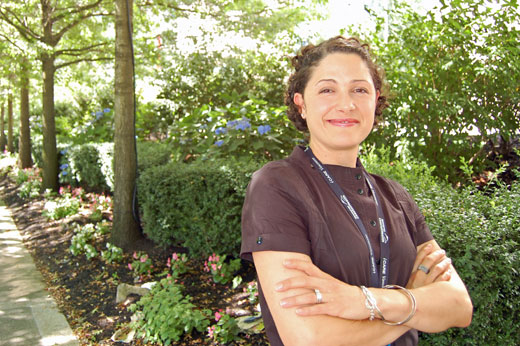
Home is best: “Just because your hospital stay is ending doesn’t mean your care is ending, too,” says Lindsay, CML with the Transitional Care Unit at UBCH.
Jude Morrison can’t contain herself. In fact, the director of resident services at Haro Park Centre is positively gushing about a resident’s transfer from UBC Hospital (UBCH).
“I had heard that we had a new model that’s improving discharge and transfers,” says Jude. “Thanks to one of the nurses at UBC Hospital, I’ve now seen for myself how it works — and I’m so impressed!”
The model Jude’s referring to is Ideal Transition Home (ITH). The nurse is Lindsay Taberner.
As care management leader for the Transitional Care Unit (TCU) at UBCH, Lindsay helps patients at moderate- to high-risk of readmission with their transition and discharge home.
“Just because your hospital stay is ending doesn’t mean your care is ending, too,” explains Lindsay. “Our goal is to ensure the supports are in place so patients can return — and stay — home as long as it’s safe to do so.”
And that’s what Lindsay and her colleagues did for a Haro Park resident who had broken her arm in a fall. “She was very anxious and probably would have been happy to stay in hospital,” Lindsay says, “but the team felt she was ready to go home.”
Seamless transition for patient
Following the ITH process, Lindsay reviewed the patient’s My Discharge Plan with her. The product of consultation with the care team and community colleagues, this plan outlines, among other things, follow-up tests and appointments, home support services and community health contacts. Lindsay also scheduled a GP visit — standard for moderate- to high-risk patients — and ensured transportation to and from the doctor’s office wouldn’t be a problem. And that’s not all.
Lindsay took the extra step of contacting Jude. “For residential care residents, I generally speak with the charge nurse, which I did, but because this patient is an assisted living resident with exceptional care needs, I contacted Jude too.”
“Lindsay contacted me well in advance, which gave us time to prepare,” says Jude. “We knew the resident would be less mobile, so we staffed up and arranged for meal delivery. We knew the medications she needed, so we could ensure she didn’t miss a dose. We even knew her arrival time, so someone was there to welcome her. And the My Discharge Plan saved staff time running around trying to fill gaps in information.”
ITH brings everyone to the table
And what does Lindsay think about the impact they’re making?
“Honestly, this means a lot to me,” she says. “ITH is bringing everyone to the table and building stronger relationships. In the end, a little extra time —including follow-up calls to patients — can make a big difference, and I know when people go home, they’ll be supported.”
Jude couldn’t agree more. “Transitions between facilities were highlighted in the BC Ombudsman’s report on seniors,” she says, “and despite best efforts on both sides of the fence we haven’t always done this very well.
“ITH is changing that and — Oh, my goodness! — it’s worth its weight in gold.”
ITH is one half of our iCARE + ITH integrated care model. To learn more, visit the iCARE + ITH Integrated Care Model site.
